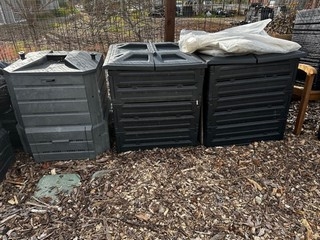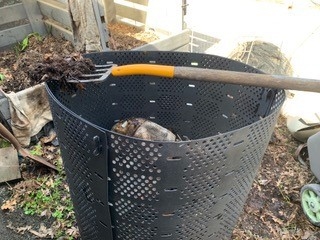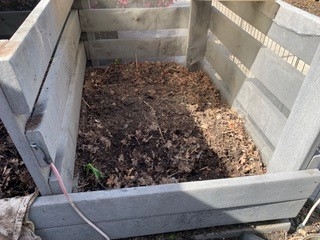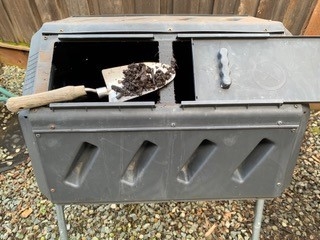From the UC Blogosphere...
Composting for the Home Gardener
We have all heard of this magical stuff called compost. But what is it? Where does it come from? Why is it so important for our gardens? The reason compost is so important is because it enriches our soil, adding important nutrients that are used by plants for growth. When we create compost, we are breaking down organic matter into a form that provides a rich amendment for the soil and promotes healthy microbial activity. With these nutrients, plants can better resist disease and insects. In addition, compost increases water retention and helps reduce soil diseases. And it can be rewarding to make your own!
What do you need for great compost?
Green material—Yard waste, kitchen vegetable scraps, coffee grounds, or fresh grass clippings. This fresh waste provides the compost's nitrogen content. Do not add meat, dairy products, oil, fat, or dog or cat manure.
Brown material—Dried leaves, torn up newspaper, pieces of cardboard boxes, or shredded paper bags. This dry material provides the carbon content. The smaller you cut the pieces, the faster the composting process will be.
How much of each—Start with equal parts of green and brown material and add up to twice as much brown material as green. Don't use more green material than brown.
Water—Water each layer of the pile to the level of a wrung out wet sponge. If the bin is exposed to rain and gets too much water, you might need to cover it.
Air—Turn the pile every few days, if possible, but at least once a week for air circulation. A pitchfork works well for turning. In addition to letting the pile “breathe”, it helps prevent problems with flies and rodents. Turning the pile helps maintain an optimal temperature, while mixing prevents dense clumping of some materials such as wet green grass.
Temperature—Heat in the pile is generated by bacteria feeding on the green material. Temperatures above 140°F will kill many pathogens and weed seeds and will also accelerate decomposition for faster composting (see below). A compost thermometer with a long probe gives good information about when to turn the pile and when to water it.
Different methods of composting—Factors to consider when choosing a method include the time and energy needed to maintain the pile, the amount of compost needed, and the time needed to achieve the finished product. The pile needs to be at least 3 feet square to generate enough heat for decomposition. You can build the compost pile right on the ground but if you build a structure to contain the pile, it should be 3–5 feet with one side open for easy access to build or turn the pile. Sun or shade does not matter as the temperature of the pile depends on its composition, not exposure to the sun. Other composting containers can include a closed container, like a rolling barrel, or an open bin composter. There are many ways to make compost: underground, above ground, in bins, in boxes, in pits, in bags, in barrels, in strips, in sheets, and in trenches.
Slow composting method (easy but slow)—Continuously add materials to the pile with little or no chopping of materials. Bury ‘green' scraps 6–12 inches in the center of your bin to reduce attracting flies and rodents. Turn and water as desired for finished compost in 12 to 18 months.
Intermediate composting method (a little more work but faster)—Build a 3' x 3' x 3' pile with materials cut into 2-inch pieces. Turn and water the pile weekly without adding more material to get finished compost in 3 to 8 months.
Fast composting method (the most work but finished fastest)—Build a 3' x 3' x 3' pile with materials chopped to ½ to 1½ inch pieces. Check the temperature of the pile every day with a thermometer in the center of the pile. Turn the pile immediately if the temperature is 150 degrees F or above. Turn and water daily while the pile is between 140–150 degrees F. As the pile cools, turn it whenever it reaches 120 degrees F. Once the pile cools below 120 degrees F, turn and water every week for finished compost in 6–8 weeks.
When is the compost done? The pile will shrink, losing about 1/3 of its volume. It will be dark brown and crumbly with an earthy smell. You should no longer be able to tell what each of the individual ingredients was. Allow compost to age for two weeks before you add it to the soil around plants. Or incorporate it into the soil, but don't sow seeds or transplant seedlings for two weeks.
For more details about composting and what materials to use:
https://sacmg.ucanr.edu/files/163139.pdf
For information about how to use compost in the home garden:
https://ucanr.edu/sites/ccmg/files/221120.pdf
This video is from our own composting experts at our demonstration garden in Walnut Creek: https://www.youtube.com/watch?v=E77Yps9K2bw The garden is open to the public on Wednesday mornings April through October. Please stop by and ask questions.
We hope to see you at Our Garden!
Help Desk of the UC Master Gardeners of Contra Costa County (JRB)
There Is No Planet 'B'
There is no "Planet B." The Earth is all we have. Today, April 22, is Earth Day (an annual event launched April 22,...
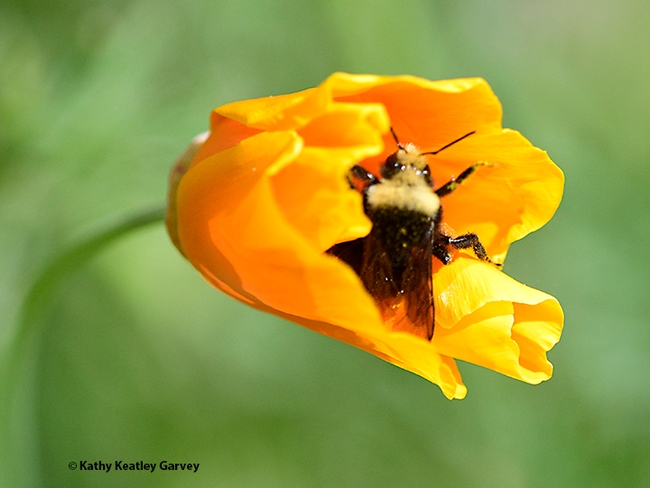
A yellow-faced bumble bee,Bombus vosnesenskii, buzzes into a barely opened California golden poppy in a Vacaville garden. (Photo by Kathy Keatley Garvey)
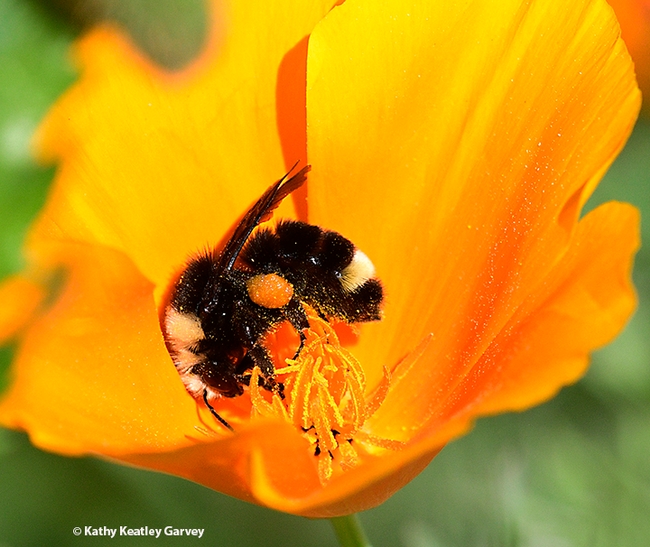
Check the orange pollen on this yellow-faced bumble bee, Bombus vosnesenskii(Photo by Kathy Keatley Garvey)
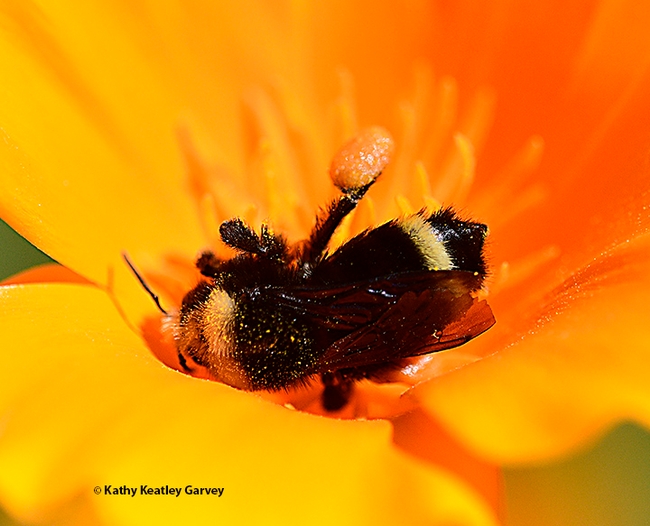
And we have a lift-off! The pollen basket is easily recognized here. (Photo by Kathy Keatley Garvey)
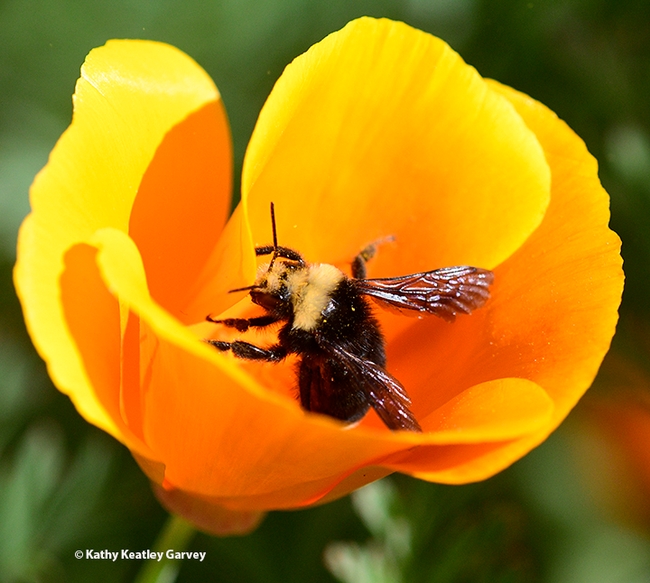
Ready for take-off! The bumble bee, Bombus vosnesenskii, prepares to leave the California golden poppy. Both are natives. (Photo by Kathy Keatley Garvey)
Gardeners with Heart: Sustainable Landscape Stewards
Watch the video on YouTube here
As we continue our celebrations of National Volunteer Month, we're excited to spotlight a remarkable group of UC Master Gardeners dedicated to nurturing vibrant habitat gardens, promoting biodiversity, and advocating for sustainable landscaping practices. These exceptional UC Master Gardeners have transformed not only gardens but also mindsets, fostering a deeper appreciation for native plants and pollinators within their community. Join us as we celebrate and express our gratitude to these outstanding "Sustainable Landscape Stewards" for their unwavering commitment to enhancing urban biodiversity and promoting environmental stewardship.
Sam Foushee, Sally Hughes, and Jennifer Cardoza, tackled the challenge of revitalizing a plot near the vegetable trials garden at the Lake Merrit Trial Garden in Alameda County into a sanctuary for native bees. Their dedication and vision have created an oasis of biodiversity focused on plants that attract, shelter and feed native bees. The garden has expanded multiple times including preserving and protecting species of native plants to promote biodiversity. This project has inspired others and helped UC Master Gardeners build a deeper understanding of planting for pollinators and overall biodiversity that they have been able to share within their communities.
Birgitt Evans, helped the Lake Merrit Trial Garden grow and expanded its efforts by focusing on creating habitat areas tailored to the needs of butterflies. Her contributions have been instrumental in supporting monarch butterflies and fostering habitats for a diverse range of butterfly species, aiding in the conservation of these vital pollinators.
Jane Margold has taken the Lake Merrit Trial Garden Project to the next stage leading a citizen science project that monitors which plants attract which types of native bees and other pollinators. When completed, this information will be available to inform local native plant gardeners in making plant selection decisions to promote pollinators in Alameda County's microclimate.
Lindy Kauffman, an exceptional leader, spearheaded the establishment of educational sustainable gardens across Mariposa County. Lindy has overseen the design and installation of gardens showcasing swales to control water, sustainable mulching methods, and the use of climate-adapted plants. These gardens serve as educational resources for volunteers and the community alike. Lindy organized a cohort of UC Master Gardeners and AmeriCorps volunteers and collaborated with county, Chamber of Commerce, and other volunteer organizations to design and install a sustainable landscaping garden with more than 100 locally adapted plants.
Ann Northrup, leverages her background in plant pathology and has been integral to the success of Santa Clara County's online Plant Clinic. Her expertise and dedication to serving home gardeners has provided invaluable support, especially during the transition to virtual clinics amid the challenges posed by the COVID-19 pandemic. Through her commitment, the online Plant Clinic continues to thrive, reaching and benefiting an ever-expanding number of participants.
As we celebrate National Volunteer Month, let us extend our heartfelt appreciation to Sam Foushee, Sally Hughes, Jennifer Cardoza, Birgitt Evans, Lindy Kauffman, and Ann Northrup. Their tireless efforts and passion for sustainability have enriched our landscapes and inspired others to join in the collective endeavor to preserve and protect California's natural resources.
About National Volunteer Month and Sustainable Landscape Stewards
During National Volunteer Month (April 1 - 30), the UC Master Gardener Program celebrates the extraordinary contributions of its volunteers to promoting sustainable landscaping practices and biodiversity conservation. Sustainable Landscape Stewards volunteers were nominated for their outstanding work in creating and maintaining habitat gardens, fostering urban biodiversity, and promoting environmental stewardship. Join us in honoring their dedication and passion for making a positive impact on the environment and the community at large. If you would like to get involved and learn more about sustainable landscaping practices in your community, you can find your local program here
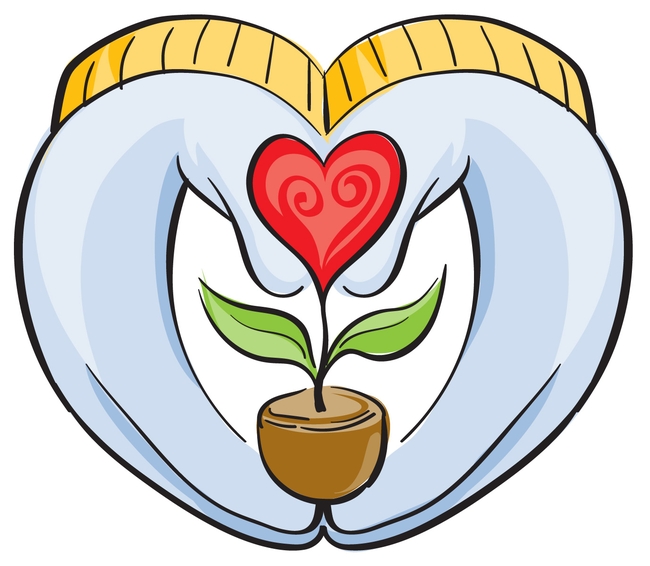
MG with heart color logo blue gloves gold trim
All the 'Bugs' at UC Davis Picnic Day Will Be at Briggs Hall
Wait! Don't head over to the Bohart Museum of Entomology in the Academic Surge Building on Crocker Lane on...
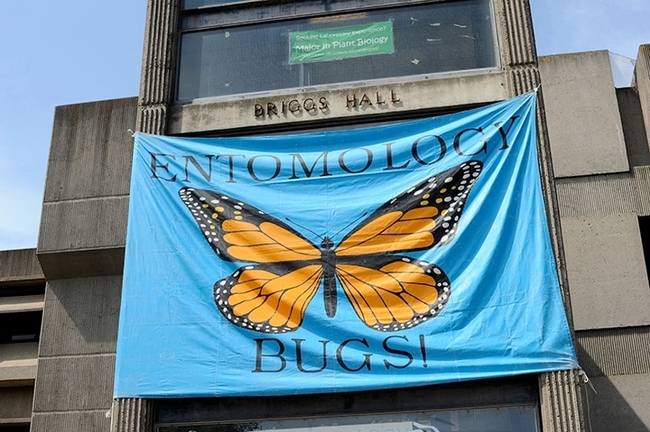
A monarch banner beckons visitors to Briggs Hall, home of the UC Davis Department of Entomology and Nematology. (Photo by Kathy Keatley Garvey)
Diversity of Arachnids to be Showcased at Briggs Hall During UC Davis Picnic Day
The UC Davis Department of Entomology and Nematology will not only celebrate insect and nematode diversity at Briggs...
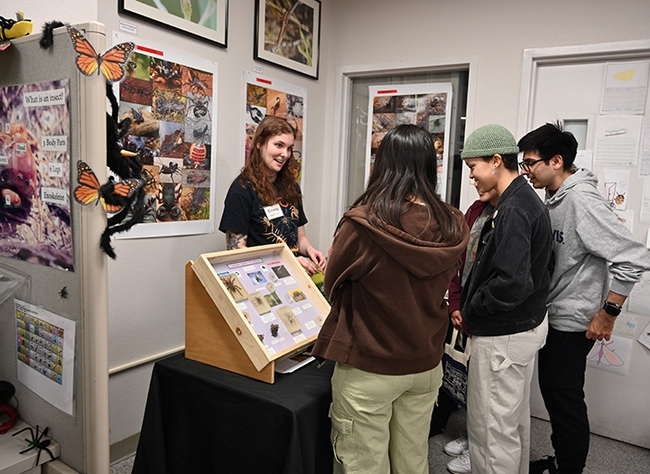
UC Davis doctoral student Emma Jochim discusses arachnids at a Bohart Museum of Entomology open house. She'll be showing the diversity of arachnids at Briggs Hall during UC Davis Picnic Day on Saturday, April 20, with colleagues. (Photo by Kathy Keatley Garvey)



